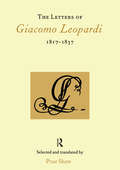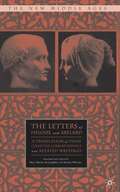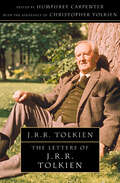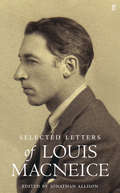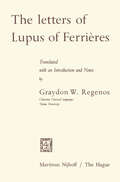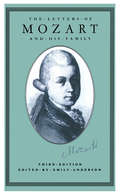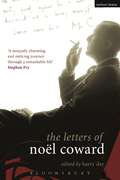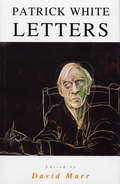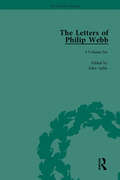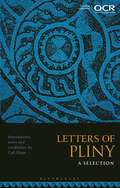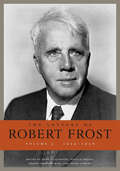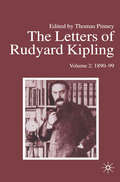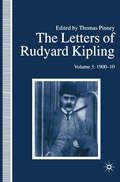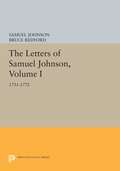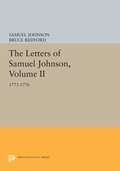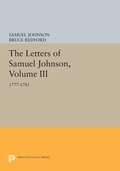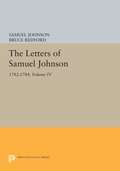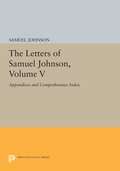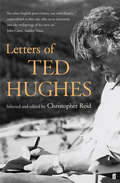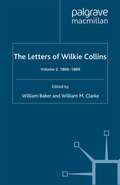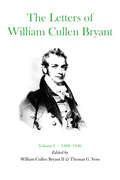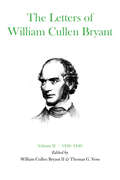- Table View
- List View
The Letters of Giacomo Leopardi 1817-1837
by Prue Shaw"Giacomo Leopardi, Italy's great poet of the Romantic age, is the author of some of the most beautiful and best-loved poems in the Italian language and some of the most remarkable letters in European literature. The interest of the letters in both biographical and literary: they document the background - the difficult personal circumstances, the intense and troubled family relationships, the contacts and friendships with other writers - against which a haunting and compelling poetic voice came to maturity. The letters, not previously available in English except fragmentarily, are here offered in a new translation undertaken to celebrate the poet's birth in 1798. In the light of growing academic interest in Italy and the re-organization of many university courses in Italian along interdisciplinary lines, this book series brings together different scholarly perspectives on Italy and its culture. Italian Perspectives incorporates books and essay collections and is published under Maney's Northern University Press Imprint. It is notable for the breadth and diversity of themes covered, incorporating all aspects and periods of Italian literature, language, history, culture, politics, art and media, as well as studies which take an interdisciplinary approach and are methodologically innovative. The series welcomes books written in English and in Italian. The Italian Perspectives series is edited by two established scholars in the field of Italian studies, supported by an international Advisory Board."
The Letters of Heloise and Abelard: A Translation of Their Collected Correspondence and Related Writings (The New Middle Ages)
by M. McLaughlin B. WheelerThe letters of Heloise and Abelard will remain one of the great, romantic and intellectual documents of human civilization while they, themselves, are probably second only to Romeo and Juliet in the fame accrued by tragic lovers. Here for the first time in Mart Martin McLaughlin's edition is the complete correspendence with commentary.
The Letters of J. R. R. Tolkien
by Humphrey Carpenter Christopher TolkienA comprehensive collection of letters spanning the adult life (1914-1973) of one of the world’s most famous storytellers.
Letters of Light: Arabic Script in Calligraphy, Print, and Digital Design
by J. R. OsbornArabic script is one of the world’s most widely used writing systems, for Arabic and non-Arabic languages alike. J. R. Osborn traces its evolution from the earliest inscriptions to digital fonts, from calligraphy to print and beyond. Students of communication, contemporary practitioners, and historians will find this narrative enlightening.
Letters of Louis MacNeice
by Louis MacNeiceLouis MacNeice is increasingly recognised as one of the greatest poets of the twentieth century, and his work has been a defining influence upon a generation of Irish poets that includes Derek Mahon, Michael Longley and Paul Muldoon.The Selected Letters is indispensable as a resource for an understanding of the intellectual culture of the mid-twentieth century. A Classics don, poet, playwright and globetrotting BBC producer, the medley and blend of MacNeice's cultural influences seems exemplary in its modernity. He kept up a significant correspondence with E. R. Dodds, Anthony Blunt and T. S. Eliot, to name but three prominent figures of the time.During his time at the BBC MacNeice witnessed many key events, including the partition of India in 1947 and the independence of the Gold Coast from Britain in 1957, and these are recorded in two long sequences to his wife, the singer Hedli Anderson.His complex relationship to Ireland and to his Irish heritages speak resonantly to contemporary debates about Irish and Northern Irish cultural identity. Finally, the Letters will do much to broaden our understanding of a vivid and often enigmatic personality whose varied life and individual charisma have often resisted explanation.
The Letters of Lupus of Ferrières
by Graydon W. RegenosThis translation ofthe letters of Lupus of Ferrieres is based primarily on the text of Diimmler' s edition, published in the M onumenta Germaniae Historica in 1902. In the arrangement of the letters, however, I have followed Levillain who sought to put them in chronological order on the basis of his own previous research published in a series of articles in the Bibliothcque de l'E:cole des chartes, volumes LXII and LXIII, in 1901 and 1902. A chronological table with suggested dating of the letters is given in this book on pages 151-153. I have attempted to keep the notes brief, confining them chiefly to identification of quoted passages and to proper names, assuming that the reader, if interested, will him self seek more detailed information in the standard sources. In a collection of letters of this nature, covering as they do such a wide range of subject matter, it is to be expected that some will have comparatively little general appeal. The few letters, for example, which deal with Latin grammar will be of little interest to most readers. Occasionally a letter may border on the trite or commonplace. It has seemed desirable, however, in view ofthe limited number of such letters, and for the sake of completeness, to include the entire collection.
The Letters of Mozart and his Family
by Wolfgang Amadeus Mozart Stanley Sadie Fiona SmartThis study has been revised to include new finds about the composition dates of several Mozart works. A new bibliography and a collation with the Neue Mozart-Ausgabe edition of letters, edited by O.E.Deutsch, W.A.Bauer and J.H.Eibl: Baerenreiter, 1962-75 is also included.
The Letters of Noël Coward (Diaries, Letters and Essays)
by Noël Coward Barry Day'A uniquely charming and enticing journey through a remarkable life.Coward's own record is made all the more delightful by the wise andhelpful interpolations of Barry Day, the soundest authority on theMaster that there is.' Stephen Fry 'Precise, witty, remarkably observed and gloriously English' Dame Judi Dench 'Barry Day's analysis is both perceptive and irresistible' Lord Richard AttenboroughWith virtually all the letters in this volume previously unpublished -this is a revealing new insight into the private life of a legendaryfigure. Coward's multi-faceted talent as an actor, writer, composer,producer and even as a war-time spy(!), brought him into close contactwith the great, the good and the merely ambitious in film, literatureand politics.With letters to and from the likes of: George BernardShaw, Virginia Woolf, Winston Churchill, Greta Garbo (she wrote askinghim to marry her), Marlene Dietriech, Ian Fleming, Graham Greene,Evelyn Waugh, Fred Astaire, Charlie Chaplin, FD Roosevelt, the QueenMother and many more, the picture that emerges is a series of vividsketches of Noel Coward's private relationships, and a re-examinationof the man himself. Deliciously insightful, witty, perfectly bitchy,wise, loving and often surprisingly moving, this extraordinarycollection gives us Coward at his crackling best. A sublime portrait ofa unique artist who made an indelible mark on the 20th century, fromthe Blitz to the Ritz and beyond.
The Letters of Noël Coward (Diaries, Letters and Essays)
by Noël Coward Barry Day'A uniquely charming and enticing journey through a remarkable life.Coward's own record is made all the more delightful by the wise andhelpful interpolations of Barry Day, the soundest authority on theMaster that there is.' Stephen Fry 'Precise, witty, remarkably observed and gloriously English' Dame Judi Dench 'Barry Day's analysis is both perceptive and irresistible' Lord Richard AttenboroughWith virtually all the letters in this volume previously unpublished -this is a revealing new insight into the private life of a legendaryfigure. Coward's multi-faceted talent as an actor, writer, composer,producer and even as a war-time spy(!), brought him into close contactwith the great, the good and the merely ambitious in film, literatureand politics.With letters to and from the likes of: George BernardShaw, Virginia Woolf, Winston Churchill, Greta Garbo (she wrote askinghim to marry her), Marlene Dietriech, Ian Fleming, Graham Greene,Evelyn Waugh, Fred Astaire, Charlie Chaplin, FD Roosevelt, the QueenMother and many more, the picture that emerges is a series of vividsketches of Noel Coward's private relationships, and a re-examinationof the man himself. Deliciously insightful, witty, perfectly bitchy,wise, loving and often surprisingly moving, this extraordinarycollection gives us Coward at his crackling best. A sublime portrait ofa unique artist who made an indelible mark on the 20th century, fromthe Blitz to the Ritz and beyond.
The Letters Of Patrick White: Letters
by David MarrFrom the time when he was a little boy, Patrick White wrote letters - brilliant, gossipy, funny, angry, heartfelt letters. When he died in 1990 at the age of 78, between 2, 500 and 3, 000 of them survived, scattered - and often treasured - all over the world. In the course of producing his much-admired biography of White, David Marr tracked down most of them. Now, with sensitivity and skill, he has assembled a rich selection from the letters to present a fascinating portrait of White in his unihibited words - as a writer, as a friend (or enemy), as a man deeply and painfully engaged with his world.
The Letters of Philip Webb
by John AplinPhilip Webb (1831-1915) was a British architect known as a founder of the Arts and Crafts movement and also a key member of the Pre-Raphaelite circle. He was an important figure in the literary and artistic world of the late-nineteenth century. Webb had a long association, both professionally and personally, with William Morris and his family as well as becoming treasurer of Morris's revolutionary Socialist League. They first met as trainees in the same architect's practice and remained collaborators throughout their lifetimes. Webb was responsible for the design of the hugely influential Red House, the Morris's first home. It was through Morris that Webb became connected with Dante Gabriel Rossetti and Edward Burne-Jones, amongst others. Webb and Morris were also joint founders of the Society for the Protection of Ancient Buildings (SPAB), the first organization to promote conservation rather than intrusive restoration. This comprehensive selection from Webb's surviving letters includes many important and previously unpublished letters to some of his closest associates. They reveal the wide range of his professional and personal interests. These four volumes will be of interest to art and architecture historians, scholars of Victorian history in general and of William Morris and the wider Pre-Raphaelite and Arts and Crafts movements in particular.
Letters of Pliny: A Selection
by Carl HopeThis is the OCR-endorsed edition covering the Latin A-Level (Group 2) prescription of Pliny, Letters 1.9; 3.16; 4.2; 4.19; 8.8; 8.16; 8.17; 9.6, giving full Latin text, commentary and vocabulary, with a detailed introduction that also covers the prescribed material to be read in English.The letters of Pliny the Younger provide a glimpse of what life at the start of the 2nd century AD was like for a member of the Roman elite, offering some insight into his roles and responsibilities, his daily concerns, and relationships both personal and professional. This wide-ranging selection includes letters of advice and praise, meditations on death and slavery, descriptions of nature or natural phenomena, and even disapproval of the Roman public's obsession with chariot-racing. Pliny shows various sides to his character and demonstrates his skill in writing, carefully constructing the persona he wants to project to posterity.Supporting resources are available on the Companion Website: https://www.bloomsbury.pub/OCR-editions-2024-2026
Letters of Pliny: A Selection
by Carl HopeThis is the OCR-endorsed edition covering the Latin A-Level (Group 2) prescription of Pliny, Letters 1.9; 3.16; 4.2; 4.19; 8.8; 8.16; 8.17; 9.6, giving full Latin text, commentary and vocabulary, with a detailed introduction that also covers the prescribed material to be read in English.The letters of Pliny the Younger provide a glimpse of what life at the start of the 2nd century AD was like for a member of the Roman elite, offering some insight into his roles and responsibilities, his daily concerns, and relationships both personal and professional. This wide-ranging selection includes letters of advice and praise, meditations on death and slavery, descriptions of nature or natural phenomena, and even disapproval of the Roman public's obsession with chariot-racing. Pliny shows various sides to his character and demonstrates his skill in writing, carefully constructing the persona he wants to project to posterity.Supporting resources are available on the Companion Website: https://www.bloomsbury.pub/OCR-editions-2024-2026
The Letters of Robert Frost, Volume 3: 1929-1936
by Robert FrostThe third installment of Harvard’s five-volume edition of Robert Frost’s correspondence. The Letters of Robert Frost, Volume 3: 1929–1936 is the latest installment in Harvard’s five-volume edition of the poet’s correspondence. It presents 589 letters, of which 424 are previously uncollected. The critically acclaimed first volume, a Times Literary Supplement Book of the Year, included nearly 300 previously uncollected letters, and the second volume 350 more. During the period covered here, Robert Frost was close to the height of his powers. If Volume 2 covered the making of Frost as America’s poet, in Volume 3 he is definitively made. These were also, however, years of personal tribulation. The once-tight Frost family broke up as marriage, illness, and work scattered the children across the country. In the case of Frost’s son Carol, both distance and proximity put strains on an already fractious relationship. But the tragedy and emotional crux of this volume is the death, in Montana, of Frost’s youngest daughter, Marjorie. Frost’s correspondence from those dark days is a powerful testament to the difficulty of honoring the responsibilities of a poet’s eminence while coping with the intensity of a parent’s grief. Volume 3 also sees Frost responding to the crisis of the Great Depression, the onset of the New Deal, and the emergence of totalitarian regimes in Europe, with wit, canny political intelligence, and no little acerbity. All the while, his star continues to rise: he wins a Pulitzer for Collected Poems in 1931 and will win a second for A Further Range, published in 1936, and he is in constant demand as a public speaker at colleges, writers’ workshops, symposia, and dinners. Frost was not just a poet but a poet-teacher; as such, he was instrumental in defining the public functions of poetry in the twentieth century. In the 1930s, Frost lived a life of paradox, as personal tragedy and the tumults of politics interwove with his unprecedented achievements. Thoroughly annotated and accompanied by a biographical glossary and detailed chronology, these letters illuminate a triumphant and difficult period in the life of a towering literary figure.
The Letters of Rudyard Kipling: Volume 2: 1890-99
by R. KiplingKipling's letters, never before collected and edited and largely unpublished, are now presented in an annotated edition based on the more than 6,000 letters preserved in public and private collections all over the world. Planned in an edition of four volumes, the Letters reveal Kipling with a fullness and immediacy of detail unmatched by any other source. The first two volumes present the first half of Kipling's life, down to the end of the nineteenth century. They show the remarkable transformation of the young schoolboy into the seasoned Indian journalist, and the even more remarkable transformation of the Indian journalist into the famous writer, the most dazzling literary success of the 1890s. Kipling's hard years of apprenticeship, his restless travels and eager encounters with cities and men, his triumphant struggles in the literary wars, are all vividly set forth. The Letters also take Kipling through his marriage and the births of his children, through the mingled happiness and distress of his American years, to the tragedy of his daughter's death at the very highest moment of his literary fame.
The Letters of Rudyard Kipling: Volume 3: 1900-10
by Thomas Pinney'The letters bring the man marvellously alive...a perfect bedside book and an important contribution to Kipling scholarship.' - Ian McIntyre, Times Volume 3 of Kipling's Letters covers the decade 1900-10, the years in which Kipling published Kim, Just So Stories, The Five Nations, Traffics and Discoveries, Puck of Pook's Hill, Actions and Reactions, and Rewards and Fairies. The narrative of his life includes the years in South Africa during and after the Boer War, his move to Bateman's in Sussex, his increasing involvement in the politics of preparedness and the growing record of his honours, culminating in the Nobel Prize.
The Letters of Samuel Johnson, Volume I: 1731-1772
by Samuel Johnson Bruce Redford"It is now become so much the fashion to publish letters, that in order to avoid it, I put as little into mine as I can," Samuel Johnson declared, according to Boswell. And Boswell answered, "Do what you will, Sir, you cannot avoid it. Should you even write as ill as you can, your letters would be published as curiosities." But Johnson's letters are far more than that. Even at their most cursory and casual, they are never less than precious biographical documents, and many of them mirror, define, and re-create a vivid likeness of the most versatile writer of eighteenth-century England. With these three volumes Princeton University Press inaugurates the first scholarly edition of this remarkable material to appear in forty years--the planned five-volume series The Letters of Samuel Johnson. Known as the Hyde Edition, the project will be completed with the fourth volume, covering the years 1782 through 1784, and the fifth, containing the comprehensive index and appendices. The series as a whole will present fifty-two previously unknown letters or parts of letters that have come to light since the publication of R. W. Chapman's three-volume set (Oxford, 1952). Such "new" letters, however, are scarcely more important than those for which only inferior printed texts or copies of varying reliability had previously been recovered. The Hyde Edition offers scores of texts transcribed for the first time from the original documents--a feature of special importance in the case of Johnson's revealing letters to Hester Thrale, many of which have been available only in expurgated form. The Hyde Edition is also the first systematically to record substantive deletions, which can yield intimate knowledge of Johnson's stylistic procedures, mental habits, and chains of association. Furthermore, its ownership credits document the current disposition of the manuscripts, hundreds of which have changed hands during the last four decades. Finally, the annotation of the letters incorporates the many significant discoveries of postwar Johnsonian scholarship, as well as decoding references that had previously resisted explanation. The result is a far richer understanding of Samuel Johnson's life, work, and milieu.Originally published in 1992.The Princeton Legacy Library uses the latest print-on-demand technology to again make available previously out-of-print books from the distinguished backlist of Princeton University Press. These editions preserve the original texts of these important books while presenting them in durable paperback and hardcover editions. The goal of the Princeton Legacy Library is to vastly increase access to the rich scholarly heritage found in the thousands of books published by Princeton University Press since its founding in 1905.
The Letters of Samuel Johnson, Volume II: 1773-1776
by Samuel Johnson Bruce RedfordThe Hyde Edition offers scores of texts transcribed for the first time from the original documents a feature of special importance in the case of Johnson's revealing letters to Hester Thrale, many of which have been available only in expurgated form. The Hyde Edition is also the first systematically to record substantive deletions, which can yield intimate knowledge of Johnson's stylistic procedures, mental habits, and chains of association. Furthermore, its ownership credits document the current disposition of the manuscripts, hundreds of which have changed hands during the last four decades. Finally, the annotation of the letters incorporates the many significant discoveries of postwar Johnsonian scholarship, as well as decoding references that had previously resisted explanation. The result is a far richer understanding of Samuel Johnson's life, work, and milieu.Originally published in 1992.The Princeton Legacy Library uses the latest print-on-demand technology to again make available previously out-of-print books from the distinguished backlist of Princeton University Press. These editions preserve the original texts of these important books while presenting them in durable paperback and hardcover editions. The goal of the Princeton Legacy Library is to vastly increase access to the rich scholarly heritage found in the thousands of books published by Princeton University Press since its founding in 1905.
The Letters of Samuel Johnson, Volume III: 1777-1781
by Samuel Johnson Bruce RedfordThe Hyde Edition offers scores of texts transcribed for the first time from the original documents a feature of special importance in the case of Johnson's revealing letters to Hester Thrale, many of which have been available only in expurgated form. The Hyde Edition is also the first systematically to record substantive deletions, which can yield intimate knowledge of Johnson's stylistic procedures, mental habits, and chains of association. Furthermore, its ownership credits document the current disposition of the manuscripts, hundreds of which have changed hands during the last four decades. Finally, the annotation of the letters incorporates the many significant discoveries of postwar Johnsonian scholarship, as well as decoding references that had previously resisted explanation. The result is a far richer understanding of Samuel Johnson's life, work, and milieu.Originally published in 1992.The Princeton Legacy Library uses the latest print-on-demand technology to again make available previously out-of-print books from the distinguished backlist of Princeton University Press. These editions preserve the original texts of these important books while presenting them in durable paperback and hardcover editions. The goal of the Princeton Legacy Library is to vastly increase access to the rich scholarly heritage found in the thousands of books published by Princeton University Press since its founding in 1905.
The Letters of Samuel Johnson, Volume IV: 1782-1784
by Samuel Johnson Bruce RedfordWith these two volumes Princeton University Press concludes the first scholarly edition of the letters of Samuel Johnson to appear in forty years. Volume IV chronicles the last three years of Johnson's life, an epistolary endgame that includes the breakup of the friendship with Hester Thrale and a poignant reaching out to new friends and new experiences. Volume V includes not only the comprehensive index but those undated letters that cannot confidently be assigned to a specific year, "ghost" letters (those whose existence is documented in other sources), three letters that have recently been recovered, and translations of Johnson's letters in Latin.Originally published in 1994.The Princeton Legacy Library uses the latest print-on-demand technology to again make available previously out-of-print books from the distinguished backlist of Princeton University Press. These editions preserve the original texts of these important books while presenting them in durable paperback and hardcover editions. The goal of the Princeton Legacy Library is to vastly increase access to the rich scholarly heritage found in the thousands of books published by Princeton University Press since its founding in 1905.
The Letters of Samuel Johnson, Volume V: Appendices and Comprehensive Index
by Samuel Johnson Bruce RedfordWith these two volumes Princeton University Press concludes the first scholarly edition of the letters of Samuel Johnson to appear in forty years. Volume IV chronicles the last three years of Johnson's life, an epistolary endgame that includes the breakup of the friendship with Hester Thrale and a poignant reaching out to new friends and new experiences. Volume V includes not only the comprehensive index but those undated letters that cannot confidently be assigned to a specific year, "ghost" letters (those whose existence is documented in other sources), three letters that have recently been recovered, and translations of Johnson's letters in Latin. Bruce Redford is Professor of English at the University of Chicago and the author of The Converse of the Pen: Acts of Intimacy in the Eighteenth-Century Familiar Letter (Chicago).Originally published in 1994.The Princeton Legacy Library uses the latest print-on-demand technology to again make available previously out-of-print books from the distinguished backlist of Princeton University Press. These editions preserve the original texts of these important books while presenting them in durable paperback and hardcover editions. The goal of the Princeton Legacy Library is to vastly increase access to the rich scholarly heritage found in the thousands of books published by Princeton University Press since its founding in 1905.
Letters of Ted Hughes
by Ted HughesAt the outset of his career Ted Hughes described letter writing as 'excellent training for conversation with the world', and he was to become a prolific master of this art. This selection begins when Hughes was seventeen, and documents the course of a life at once resolutely private but intensely attuned to others. It is a fascinatingly detailed picture of a mind of genius as it evolved through an incomparably eventful life and career.
The Letters of Wilkie Collins: Volume 2
by William Baker William M. ClarkeWilkie Collins is the only leading Victorian novelist whose letters have not been published. This two-volume edition, edited by William Baker and William Clarke, fills a gaping hole in any assessment of one of the nineteenth century's most loved novelists. It is also extremely timely. Two recent biographies have re-assessed his private life and his literary achievements. His best-known novels, The Women in White and The Moonstone, continue to feature on television, and most of his thirty-odd novels are still in print. This authorised edition reproduces his selection of around 700 key letters of the 2,000 known to be in existence, some recently discovered. Summaries and sources of the remaining letters are provided in an appendix.
The Letters of William Cullen Bryant: Volume I, 1809–1836
by William Cullen BryantThis is the only collection ever made of Bryant's letters, two-thirds of which have never before been printed. Their publication was foreseen by the late Allan Nevin as "one of the most important and stimulating enterprises contributory to the enrichment of the nation's cultural and political life that is now within range of individual and group effort.William Cullen Bryant (1794–1878) was America's earliest national poet. His immediate followers—Longfellow, Poe, and Whitman—unquestionably began their distinguished careers in imitation of his verses. But Bryant was even more influential in his long career as a political journalist, and in his encouragement of American art, from his lectures at the National Academy of Design in 1828 to his evocation of the Metropolitan Museum of Art in 1870. Between the appearance of his first major poem, "Thanatopsis," in 1817, and his death sixty-one years later at the age of eight-three, Bryant knew and corresponded with an extraordinary number of eminent men and women. More than 2,100 of his know letters have already been recovered for the present edition.When William Cullen Bryant signed the first of 314 letters in the present volume, in 1809, he was a frail and shy farm boy of fourteen who had nonetheless already won some fame as the satirist of Thomas Jefferson. When he wrote the last, in 1836, he had become the chief poet of his country, the editor of its principal liberal newspaper, and the friend and collaborator of its leading artists and writers. His collected poems, previously published at New York, Boston, and London, were going into their third edition. His incisive editorials in the New York Evening Post were affecting the decisions of Andrew Jackson's administration. His poetic themes were beginning to find expression in the landscape paintings of Robert Weir, Asher Durand, and Thomas Cole.The early letters gathered here in chronological order give a unique picture of Cullen Bryant's youth and young manhood: his discipline in the classics preparatory to an all-too-brief college tenure; his legal study and subsequent law practice; the experiments with romantic versification which culminated in his poetic masterpieces, and those with the opposite sex which led to his courtship and marriage; his eager interest in the politics of the Madison and Monroe Presidencies, and his subsequent activities as a local politician and polemicist in western Massachusetts; his apprenticeship as magazine editor and literary critic in New York City, from which his later eminence as journalist was the natural evolution; the lectures on poetry and mythology which foreshadowed a long career as occasional orator; the collaboration in writing The Talisman, The American Landscape, and Tales of Glauber-Spa, and in forming the National Academy of Design, and the Sketch Club, which brought him intimacy with writers, artists, and publishers; his first trip to the Aemrican West, and his first long visit to Europe, during which he began the practice of writing letters to his newspaper which, throughout nearly half a century, proved him a perceptive interpreter of the distant scene to his contemporaries.Here, in essence, is the first volume of the autobiography of one whom Abraham Lincoln remarked after his first visit to New York City in 1860, "It was worth the journey to the East merely to see such a man." And John Bigelow, who of Bryant's many eulogists knew him best, said in 1878 of his longtime friend and business partner, "There was no eminent American upon whom the judgment of his countrymen would be more immediate and unanimous. The broad simple outline of his character and career had become universally familiar, like a mountain or a sea."
The Letters of William Cullen Bryant: Volume II, 1836–1849
by William Cullen BryantThe second volume of William Cullen Bryant's letters opens in 1836 as he has just returned to New York from an extended visit to Europe to resume charge of the New York Evening Post, brought near to failure during his absence by his partner William Leggett's mismanagement. At the period's close, Bryant has found in John Bigelow an able editorial associate and astute partner, with whose help he has brought the paper close to its greatest financial prosperity and to national political and cultural influence.Bryant's letters lf the years between show the versatility of his concern with the crucial political, social, artistic, and literary movements of his time, and the varied friendships he enjoyed despite his preoccupation with a controversial daily paper, and with the sustenance of a poetic reputation yet unequaled among Americans. As president of the New York Homeopathic Society, in letters and editorials urging widespread public parks, and in his presidency of the New York Society for the Abolition of the Punishment of Death, he gave attention to public health, recreation, and order. He urged the rights of labor, foreign and religious minorities, and free African Americans; his most powerful political effort of the period was in opposition to the spread of slavery through the conquest of Mexico. An early commitment to free trade in material goods was maintained in letters and editorials, and to that in ideas by his presidency of the American Copyright Club and his support of the efforts of Charles Dickens and Harriet Martineau to secure from the United States Congress and international copyright agreement.Bryant's first visit to Great Britain came at the height of his poetic and journalistic fame in 1845, bringing him into cordial intimacy with members of Parliament, scientists, journalists, artists, and writers. In detailed letters to his wife, published here for the first time, he describes the pleasures he took in breakfasting with the literary patron Samuel Rogers and the American minister Edward Everett, boating on the Thames with artists and with diarist Henry Crabb Robinson, spending an evening in the home of Leigh Hunt, and calling on the Wordsworths at Rydal Mount as well as in the distinctions paid him at a rally of the Anti-Corn-Law League in Covent Garden Theatre, and at the annual meeting in Cambridge of the British Association for the Advancement of Science.Equally fresh are most of the letters to prominent Americans, many of them his close friends, such as the two Danas, Bancroft, Cole, Cooper, Dewey, Dix, Downing, Durand, Forrest, Greenough, Irving, Longfellow, Simms, Tilden, Van Buren, and Weir. His letters to the Evening Post recounting his observations and experiences during travels abroad and in the South, West, and Northeast of the United States, which were copied widely in other newspapers and praised highly by many of their subscribers, are here made available to the present-day reader.
